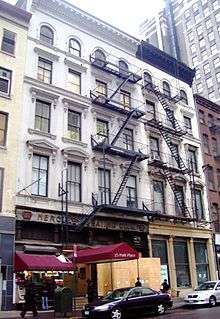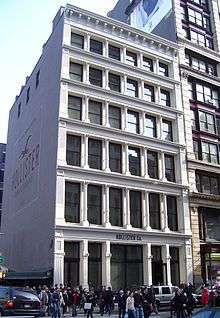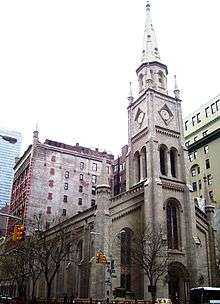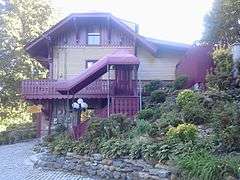Samuel A. Warner
| Samuel A. Warner | |
|---|---|
| Born |
Samuel Adams Warner 1822 |
| Died | 1897 (aged 75) |
| Occupation | American architect |

23 & 25 Park Place from the West

428 Broadway

600 Broadway
.jpg)
A photochrom postcard of the Marble Collegiate Church c. 1897 – 1924
Samuel Adams Warner (1822–1897) was an American architect.[1] He studied architecture in his father Cyrus L. Warner's office and partnered with his younger brother Benjamin Warner from 1862 to 1868. He designed dry goods merchant buildings including for H.B. Claflin Co., S.B. Chittendon & Co., Charles St. John, and H.D. Aldrich. He also designed the Marble Collegiate Church and several buildings in SoHo's Cast Iron Historic District from 1879 and 1895.[2]
Benjamin Warner is credited with designing 33 Greene Street at the Northwest corner of Grand Street (1873).[3]
Work
- Samuel Adams Warner House, the architect's home, which he designed, in Roslyn, New York
- Marble Collegiate Church (1881–1854), a Gothic Revival architecture church at 1 West 29th Street on the Northwest corner of 5th Avenue in New York City[3]
- Presbyterian Church of the Redeemer (now Our Lady of Peace Roman Catholic Church) (1886–1887) at 239 East 62nd Street between 2nd Ave. and 3rd Avenue in New York City[3]
- 16-18 Greene Street, NYC[3]
- 20-26 Greene Street (1880), NYC[3]
- 39-41 Worth Street[3]
- 600 Broadway (1884)[3]
- 545 Broadway (1885) West Side[3]
- 426-432 Broadway 1888-89 [2]
![]() Media related to Samuel A. Warner at Wikimedia Commons
Media related to Samuel A. Warner at Wikimedia Commons
References
- ↑ SAMUEL A. WARNER DEAD; Wealthy New York Architect Passes Away in Roslyn, L.I. -- Sketch of His Career. New York Times
- 1 2 "Category: Samuel A. Warner | SoHo Historic Architecture". web.archive.org. Retrieved 2015-02-13.
- 1 2 3 4 5 6 7 8 White, N.; Willensky, E.; Leadon, F. (2010). AIA Guide to New York City. Oxford University Press, USA. p. 116. ISBN 9780199772919. Retrieved 2015-02-13.
This article is issued from Wikipedia - version of the 6/4/2016. The text is available under the Creative Commons Attribution/Share Alike but additional terms may apply for the media files.

